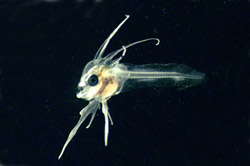Pictures from a microscopic world

Larvae of monkfish/anglerfish (Lophius vomerinus) ca. 5mm. The dorsal, pectoral and pelvic fins are very elongate at this stage.
The planktonic eggs and larvae are small and are best viewed through a microscope and therefore unknown to most people. Many of the species or close relatives are found also in more northern waters, and species such as monkfish, pearlside, horse mackerel, blackbelly rosefish (jacopever), gurnard and John dory are well known.
During our surveys in Namibia and South Africa we manage to identify most eggs and larvae. Since this is a relatively cold upwelling area, few species dominates and these are well documented in the literature even in the egg and larval stages. The challenge increases when we sometimes cross the front between the cold Benguela water and the warmer water of the Angola current. The number of species increase and many of the species are not well documented on the egg and larval stage.
In cooperation with local institutions, IMR has conducted several hake surveys in the region. The main goal has been to assess the stock size, but recently the focus has been directed towards life history studies and particularly to investigate whether the stocks of hake are shared between Namibia and South Africa. During last year's survey, we tried to map the spawning areas and the eggs and larval drift routes.
Media Contact
More Information:
http://www.imr.no/english/news/news_2006/a_microscopic_worldAll latest news from the category: Ecology, The Environment and Conservation
This complex theme deals primarily with interactions between organisms and the environmental factors that impact them, but to a greater extent between individual inanimate environmental factors.
innovations-report offers informative reports and articles on topics such as climate protection, landscape conservation, ecological systems, wildlife and nature parks and ecosystem efficiency and balance.
Newest articles

Combatting disruptive ‘noise’ in quantum communication
In a significant milestone for quantum communication technology, an experiment has demonstrated how networks can be leveraged to combat disruptive ‘noise’ in quantum communications. The international effort led by researchers…

Stretchable quantum dot display
Intrinsically stretchable quantum dot-based light-emitting diodes achieved record-breaking performance. A team of South Korean scientists led by Professor KIM Dae-Hyeong of the Center for Nanoparticle Research within the Institute for…

Internet can achieve quantum speed with light saved as sound
Researchers at the University of Copenhagen’s Niels Bohr Institute have developed a new way to create quantum memory: A small drum can store data sent with light in its sonic…





















